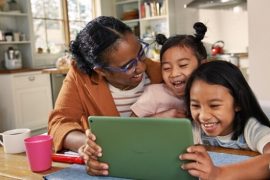Parents often wonder if getting their kids a tablet or a phone is a bad idea; do you find yourself thinking along those lines when your kid seems to lose interest in all other forms of family engagement?
Many digital age parents can relate with this; it could be that little girl that never looks up from her computer or the boy that just can’t wait to dash off the dinner table and back to his play station, let’s not forget the preteen who only communicates through texts. Yes! We’ve seen it all and it gets you wondering; are these tech gadgets building or bridging the communication gap? And if it is, what do we do; or is it back to the analogue days?
In a world where children are “growing up digital,” it becomes necessary to ensure that they learn healthy concepts of digital use, and parents play an important role in teaching these skills.
A 2013 report by daily mail revealed that nearly a third of children now learn to use a mobile phone or a tablet computer before they can talk. About 29 percent started using the gadgets as toddlers, with 70 percent mastering them completely by primary school age. This simply says we cannot go back in time, but there are ways of bridging the communication gap.
The American Academy of Pediatrics highlights a few tips to help parents better manage their kids’ tech time.
- Make your own family media use plan. Media should work for you and within your family values and parenting style. When used thoughtfully and appropriately, the media can enhance daily life. But when used inappropriately or without thought, media can displace many important activities such as face-to-face interaction, family-time, outdoor-play, exercise, unplugged downtime, and sleep.
- Treat media as you would any other environment in your child’s life. The same parenting guidelines apply in both real and virtual environments. Set limits; kids need and expect them. Know your children’s friends, both online and off. Know what platforms, software, and apps your children are using, what sites they are visiting on the web, and what they are doing online.
- Set limits and encourage playtime. Media use, like all other activities, should have reasonable limits. Unstructured and offline play stimulates creativity. Make unplugged playtime a daily priority, especially for very young children. And don’t forget to join your children in unplugged play whenever possible.
- Families who play together, learn together. Family participation is also great for media activities it encourages social interactions, bonding, and learning. Play a video game with your kids. It’s a good way to demonstrate good sportsmanship and gaming etiquette. You will have the opportunity to introduce and share your own life experiences and perspective and guidance as you play the game.
- Be a good role model. Teach and model kindness and good manners online. Because children are great mimics, limit your own media use. In fact, you’ll be more available for and connected with your children if you’re interacting, hugging and playing with them rather than simply staring at a screen.
- Know the value of face-to-face communication. Very young children learn best through two-way communication. Engaging in back-and-forth “talk time” is critical for language development. Conversations can be face-to-face or, if necessary, by video chat with a travelling parent or far-away grandparent. Research has shown that it’s that “back-and-forth conversation” that improves language skills much more so than “passive” listening or one-way interaction with a screen.
- Limit digital media for your youngest family members. Avoid digital media for toddlers younger than 18 to 24 months other than video chatting. For children 18 to 24 months, watch digital media with them because they learn from watching and talking with you. Limit screen use for preschool children, ages 2 to 5, to just 1 hour a day of high-quality programming, and watch it with them so you can help them learn from what they’re seeing.
- Create tech-free zones. Keep family mealtimes, other family and social gatherings, and children’s bedrooms screen free. Turn off televisions that you aren’t watching, because background TV can get in the way of face-to-face time with kids. Recharge devices overnight outside your child’s bedroom to help children avoid the temptation to use them when they should be sleeping. These changes encourage more family time, healthier eating habits, and better sleep, all critical for children’s wellness.
- Don’t use technology as an emotional pacifier. Media can be very effective in keeping kids calm and quiet, but it should not be the only way they learn to calm down. Children need to be taught how to identify and handle strong emotions, come up with activities to manage boredom, or calm down through breathing, talking about ways to solve the problem, and finding other strategies for channelling emotions.
- Apps for kids – do your homework. More than 80,000 apps are labelled as educational, but little research has demonstrated their actual quality. Products pitched as “interactive” should require more than “pushing and swiping.” Look to organizations like Common Sense Media for reviews about age-appropriate apps, games and programs to guide you in making the best choices for your children.
- It’s OK for your teen to be online. Online relationships are part of typical adolescent development. Social media can support teens as they explore and discover more about themselves and their place in the grown-up world. Just be sure your teen is behaving appropriately in both the real and online worlds. Many teens need to be reminded that a platform’s privacy settings do not make things actually “private” and that images, thoughts, and behaviours teens share online will instantly become a part of their digital footprint indefinitely. Keep lines of communication open and let them know you’re there if they have questions or concerns.
Media and digital devices are an integral part of our world today. The benefits of these devices, if used moderately and appropriately, can be great. But, research has shown that face-to-face time with family, friends, and teachers plays a pivotal and even more important role in promoting children’s learning and healthy development. Keep the face-to-face upfront, and don’t let it get lost in a stream of media and tech.




